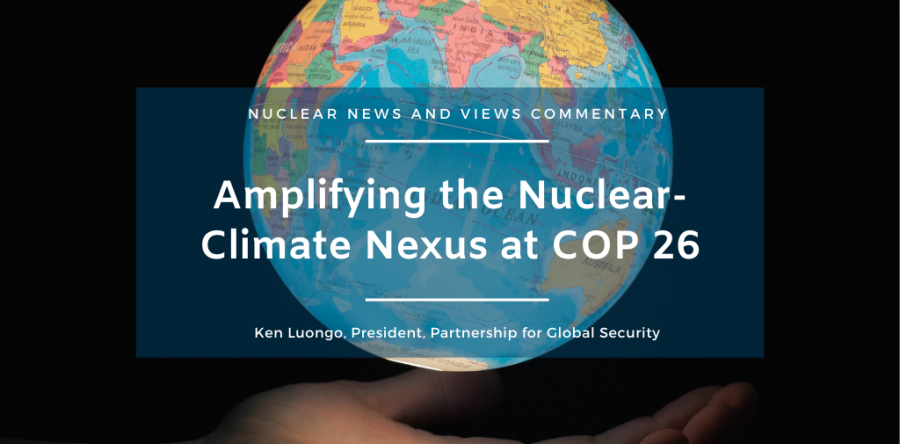China apparently didn’t want to contribute to the excessive hot air being emitted at the Glasgow climate COP, so it’s leaders skipped out.
Instead it is preparing to spend up to $440 billion building 150 new nuclear reactors to achieve its goal of achieving net-zero carbon emissions by 2060.
By contrast, the U.S. sent the president and 13 high-level officials and cabinet secretaries to Glasgow. It’s collective nuclear ambition at the summit was $25 million for a Nuclear Futures Package designed to support a few nations interested in nuclear energy and the announcement of a plan to build a six-module SMR in Romania.
This comparison is unflattering and a bit unfair because the U.S. is committing several billion dollars per year to nuclear energy, with a big focus on developing and proving next-generation reactors.
The Biden administration also has proposed another $10 billion plus to support existing and next-gen nuclear energy in its currently stalled bipartisan infrastructure bill. And there are tax incentives to support nuclear power’s zero-carbon output in the Build Back Better bill, which currently is a slippery political football on Capitol Hill.
But beyond the financial commitment to maintain the role of nuclear power’s climate benefits, the administration limits its public enthusiasm about the issue, has not developed a nuclear-climate nexus strategy that will allow it to take advantage of its next-gen nuclear investments, and has been mostly silent about the matter in Glasgow.
The reason for this reticence is well documented in a newly released U.S. strategy for achieving net-zero emissions by 2050. There is a graph in the middle of the document that identifies the nation’s objectives for clean energy growth by technology.
Renewable energy increases from less than 1 Terawatt-hour at present to potentially 7 Terawatt-hours in 2050. Nuclear power is identified as remaining “in operation” with potentially modest growth “in the 2030s and 2040s.”
There are no specifics on the types of reactors to be deployed. And no acknowledgement that by the 2050’s many of the current reactors that provide over 50% of U.S. zero-carbon electricity will be ready for retirement, necessitating replacement or substitution of their clean energy output.
How the renewable energy miracle anticipated in the U.S. strategy will be achieved in less than 30 years is not made completely clear in the document.
But it does identify the “substantial” challenges to it: “sufficient pace” of deployment; “new transmission, distribution, and storage infrastructure”; “longer duration storage solutions”; stressed supply chains including “rare earth elements”; “manufacturing capacity”; and “skilled workforce”. Absent from the list is the limit of public acceptance of territory-intrusive technologies.
Overcoming all of these barriers inevitably would establish the U.S. as an international clean energy powerhouse. But success is not guaranteed and betting the overwhelming majority of U.S. carbon reductions on renewables is a risky proposition for U.S. energy reliability, geopolitical influence, and global security.
In a new debate published in Foreign Affairs, many of these concerns are analyzed in the context of the role that nuclear power can play as a global zero-carbon workhorse.
Other countries are coming to grips with the limits of renewable energy as their primary decarbonization technology and are looking anew at nuclear.
The leaders of Hungary and South Korea issued a statement this week in which they agreed that, “climate neutrality cannot be achieved without nuclear energy.”
That declaration was echoed by the Director General of the IAEA, who noted that, “Nuclear is, and will be, part of the solution if we are to achieve the goal of limiting global warming to below 2 degrees Celsius.”
There also was a Tweet from the European Commission president asserting “We need more renewables. We also need a stable source, nuclear, and during the transition, gas.” This is a potential precursor to the inclusion of nuclear power and natural gas in the EU’s green finance taxonomy.
Then there are the fraught geopolitics of clean energy. A recent U.S. intelligence report underscored that the race to decarbonize will ratchet up geopolitical tensions.
Right now, the renewable energy superhighway runs right through China, and it has demonstrated that it will cutoff trade when faced with stiff political challenges from abroad.
When viewed in the aggregate, it seems like a significant number of U.S. allies – including Britain, France, South Korea, Japan, India, Canada, Poland, and Romania - are coming to realize that they need a stable zero-carbon energy backbone to support their deployment of renewables. Their choice is nuclear. The U.S. should be positioning itself to play a leading role in supporting this trend.
Nuclear power also is a primary clean energy source of America’s major challengers, China and Russia. They are aggressively cultivating nuclear export markets and see their domestic nuclear deployments as a necessary springboard for success abroad.
This is important because the Biden team has been tepid on the high stakes of losing the race to control the global nuclear market of the 21st Century. The winner of this international competition will exert significant influence over the governance rules for the nuclear technologies of the future. That, in turn, will have a direct impact on the potential for nuclear proliferation, security, and terrorism.
The nuclear-climate-global security nexus is now a knot that cannot be untied. But in Glasgow the U.S. is gliding past its importance and implications. China is not.
Ken Luongo, President, Partnership for Global Security


